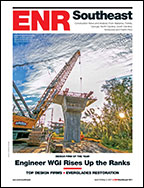Residential building, at $214.4 billion (annual rate), grew 4% in April. The residential increase was the result of another gain for multifamily housing, which bounced back 19% in April after slipping 9% in March. April’s level of activity for multifamily housing was 24% above its average monthly pace registered during 2013. There were four large multifamily projects in the New York City metropolitan area included as April starts—a $175-million apartment building in Queens, plus three apartment building projects in Manhattan valued respectively at $125 million, $106 million and $95 million.
Through the January-April period of 2014, the top five metropolitan areas in terms of the dollar amount of new multifamily starts were: New York City, Washington, D.C., Miami, Boston and Los Angeles.
Single-family housing in April slipped an additional 1% and has now shown modest deterioration for six consecutive months. April’s level of activity for single-family housing was 4% below its average monthly pace registered during 2013.
“There’s growing concern that tight standards by mortgage lenders, particularly to first-time homebuyers, are holding back the single-family recovery, and federal regulators are now looking at ways to encourage Fannie Mae and Freddie Mac to make credit more available to potential homebuyers,” said Robert A. Murray, chief \economist, McGraw Hill Construction
Nonbuilding Construction
Nonbuilding construction in April decreased 14% to $116.5 billion (annual rate), after posting gains in the previous two months. The public works sector in April retreated 10%. Highway work dropped 23% while bridge construction fell an even steeper 43%, given the comparison to March, which included the start of the $585-million Gerald Desmond Bridge replacement project in California.
“While the Senate has made progress towards finalizing a new multiyear federal transportation bill, it’s still uncertain whether the full Congress will be able to approve a new bill by the time the current two-year legislation expires on September 30,” Murray said. “In addition, concern about whether the Highway Trust Fund will run out of money by summer has caused state departments of transportation to more carefully consider going ahead with major projects.”
The miscellaneous public works category, comprised of sitework, mass transit and pipelines, plunged 44% in April. In contrast, the environmental public works categories showed healthy percentage growth in April. River/harbor development jumped 84%, aided by the start of the $240-million Anacostia River Tunnel in Washington, D.C., and the $200-million Rockaway Beach Boardwalks project in Far Rockaway, N.Y.
Water supply construction in April climbed 57%, while sewer construction advanced 39%. Electric utility construction in April dropped 29%, returning to its downward trend after registering a 170% hike in March. There were a few large electric utility projects reaching the construction start stage in April, including a $750-million solar-power facility in Nevada and a $350-million wind farm in North Dakota, but these were not enough to avert a pullback for the electric utility category.
The “no change” for total construction starts on an unadjusted basis in the first four months of 2014 relative to last year was due to a varied pattern by major sector. Nonresidential building during the January-April period advanced 4%, helped by a 75% increase for manufacturing plants but restrained by these year-to-date declines—commercial building, down 3%; and institutional building, down 4%.
Residential building during the first four months of 2014 grew 3%, with multifamily housing up 13% while single-family housing was flat compared to last year. Nonbuilding construction during the first four months of 2014 dropped 10%, with weaker activity for public works, down 9%; and electric utilities, down 15%.
By geography, total construction starts during the first four months of 2014 revealed gains in the Northeast, up 6%; and the South Central, up 4%; while decreased activity was reported in the West, down 1%; the South Atlantic, down 5%; and the Midwest, down 6%.


Post a comment to this article
Report Abusive Comment